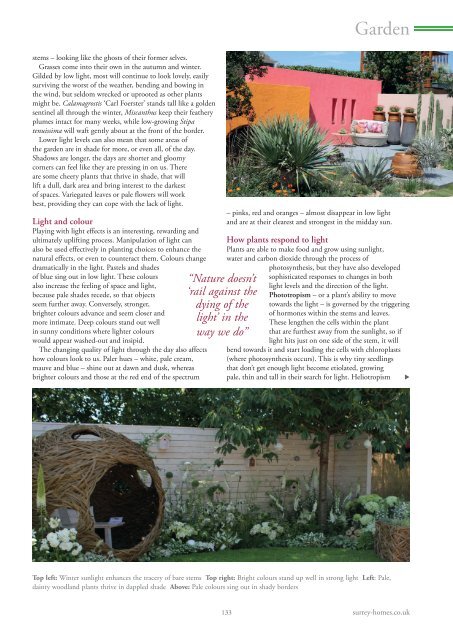Surrey Homes | SH60 | October 2019 | Kitchen & Bathroom supplement inside
The lifestyle magazine for Surrey - Inspirational Interiors, Fabulous Fashion, Delicious Dishes
The lifestyle magazine for Surrey - Inspirational Interiors, Fabulous Fashion, Delicious Dishes
You also want an ePaper? Increase the reach of your titles
YUMPU automatically turns print PDFs into web optimized ePapers that Google loves.
Garden<br />
stems – looking like the ghosts of their former selves.<br />
Grasses come into their own in the autumn and winter.<br />
Gilded by low light, most will continue to look lovely, easily<br />
surviving the worst of the weather, bending and bowing in<br />
the wind, but seldom wrecked or uprooted as other plants<br />
might be. Calamagrostis ‘Carl Foerster’ stands tall like a golden<br />
sentinel all through the winter, Miscanthus keep their feathery<br />
plumes intact for many weeks, while low-growing Stipa<br />
tenuissima will waft gently about at the front of the border.<br />
Lower light levels can also mean that some areas of<br />
the garden are in shade for more, or even all, of the day.<br />
Shadows are longer, the days are shorter and gloomy<br />
corners can feel like they are pressing in on us. There<br />
are some cheery plants that thrive in shade, that will<br />
lift a dull, dark area and bring interest to the darkest<br />
of spaces. Variegated leaves or pale flowers will work<br />
best, providing they can cope with the lack of light.<br />
Light and colour<br />
Playing with light effects is an interesting, rewarding and<br />
ultimately uplifting process. Manipulation of light can<br />
also be used effectively in planting choices to enhance the<br />
natural effects, or even to counteract them. Colours change<br />
dramatically in the light. Pastels and shades<br />
of blue sing out in low light. These colours<br />
also increase the feeling of space and light,<br />
because pale shades recede, so that objects<br />
seem further away. Conversely, stronger,<br />
brighter colours advance and seem closer and<br />
more intimate. Deep colours stand out well<br />
in sunny conditions where lighter colours<br />
would appear washed-out and insipid.<br />
The changing quality of light through the day also affects<br />
how colours look to us. Paler hues – white, pale cream,<br />
mauve and blue – shine out at dawn and dusk, whereas<br />
brighter colours and those at the red end of the spectrum<br />
“Nature doesn’t<br />
‘rail against the<br />
dying of the<br />
light’ in the<br />
way we do”<br />
– pinks, red and oranges – almost disappear in low light<br />
and are at their clearest and strongest in the midday sun.<br />
How plants respond to light<br />
Plants are able to make food and grow using sunlight,<br />
water and carbon dioxide through the process of<br />
photosynthesis, but they have also developed<br />
sophisticated responses to changes in both<br />
light levels and the direction of the light.<br />
Phototropism – or a plant’s ability to move<br />
towards the light – is governed by the triggering<br />
of hormones within the stems and leaves.<br />
These lengthen the cells within the plant<br />
that are furthest away from the sunlight, so if<br />
light hits just on one side of the stem, it will<br />
bend towards it and start loading the cells with chloroplasts<br />
(where photosynthesis occurs). This is why tiny seedlings<br />
that don’t get enough light become etiolated, growing<br />
pale, thin and tall in their search for light. Heliotropism<br />
<br />
Top left: Winter sunlight enhances the tracery of bare stems Top right: Bright colours stand up well in strong light Left: Pale,<br />
dainty woodland plants thrive in dappled shade Above: Pale colours sing out in shady borders<br />
133 surrey-homes.co.uk


















